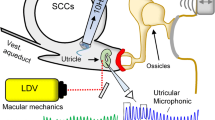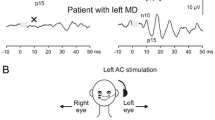Abstract
This study aimed to establish an animal model of ocular vestibular-evoked myogenic potential (oVEMP) in guinea pigs. Ten healthy and 10 gentamicin-treated guinea pigs underwent oVEMP test using a hand-held bone-conducted vibrator placed on the animal’s forehead. All 10 healthy animals exhibited bilateral oVEMPs at the stimulus intensity of 139 dB force level (FL), with a mean threshold and latencies of peak nI and pI of 130 ± 4 dBFL, 3.17 ± 0.37 ms and 4.72 ± 0.38 ms, respectively. Similar to response rate, the nI–pI amplitude decreased markedly in magnitude as stimulus intensity decreased. Another 10 animals administered with gentamicin (2 mg) on the left ear 1 week after surgery had 100% clear oVEMPs beneath the left eye (ipsilateral to the lesion side), whereas oVEMPs were absent and reduced beneath the right eye (opposite to the lesion side) in 7 and 3 animals, respectively. Morphological study of animals with absent oVEMPs identified substantial damage to the hair cells of the utricular macula. Quantitative analysis revealed that histological density of intact hair cells of the utricular macula from control and lesion ears were 194 ± 15 and 66 ± 9 per 130 × 130 μm2 field, respectively, showing a 68% reduction in the latter. Further, the stereocilia of the residual hair cells were either fused or deformed, and pointed outward randomly. In conclusion, this study establishes the animal model of oVEMP in guinea pigs using bone-conducted vibration stimuli, which sets the stage for investigating the pathophysiology of the utricular disorders.





Similar content being viewed by others
References
Bergstrom B (1973) Morphology of the vestibular nerve. II. The number of myelinated vestibular nerve fibers in man at various ages. Acta Otolaryngol 76:173–179
Cohen B, Suzuki JI, Bender MB (1964) Eye movements from semicircular canal nerve stimulation in the cat. Ann Otol Rhinol Laryngol 73:153–169
Colebatch JG, Halmagyi GM, Skuse NF (1994) Myogenic potentials generated by a click-evoked vestibulocollic reflex. J Neurol Neurosurg Psychiatry 57:190–197
Curthoys IS (2010) A critical review of the neurophysiological evidence underlying clinical vestibular testing using sound, vibration and galvanic stimuli. Clin Neurophysiol 121:132–144
Curthoys IS, Kim J, McPhedran SK, Camp AJ (2006) Bone-conducted vibration selectively activates irregular primary otolithic vestibular neurons in the guinea pig. Exp Brain Res 175:256–267
Day AS, Lue JH, Yang TH, Young YH (2007) Effect of intratympanic application of aminoglycosides on click-evoked myogenic potentials in guinea pigs. Ear Hear 28:18–25
De Burlet HM (1924) Zur Innervation der Macula sacculi bei Saugetieren. Anat Anzig 58:26–32
Didier A, Cazals Y (1989) Acoustic responses recorded from the saccular bundle on the eighth nerve of the guinea pigs. Hear Res 37:123–128
Fernandez C, Goldberg JM, Abend WK (1972) Response to static tilts of peripheral neurons innervating otolith organs of the squirrel monkey. J Neurophysiol 35:978–987
Goldberg JM (2000) Afferent diversity and the organization of central vestibular pathways. Exp Brain Res 130:277–297
Halmagyi GH, Aw ST, Cremer PD, Curthoys IS, Todd MJ (2001) Impulsive testing of individual semicircular canal function. Ann NY Acad Sci 942:192–200
Iwasaki S, McGarvie LA, Halmagyi GM, Burgess AM, Kim J, Colebatch JG, Curthoys IS (2007) Head taps evoke a crossed vestibulo-ocular reflex. Neurology 68:1227–1229
Iwasaki S, Chihara Y, Smulders YE, Burgess AM, Halmagyi GM, Curthoys IS, Murofushi T (2009) The role of the superior vestibular nerve in generating Ocular vestibular-evoked myogenic potentials to bone-conducted vibration at Fz. Clin Neurophysiol 20:588–593
Lue JH, Day AS, Cheng PW, Young YH (2009) Vestibular evoked myogenic potentials are heavily dependent on type I hair cell activity of the saccular macula in guinea pigs. Audiol Neurotol 14:59–66
Mason S, Garnham C, Hudson B (1996) Electric response audiometry in young children before cochlear implantation: a short latency component. Ear Hear 17:537–543
Murofushi T, Curthoys IS, Topple AN, Colebatch JG, Halmagyi GM (1995) Responses of guinea pig primary vestibular neurons to clicks. Exp Brain Res 103:174–178
Rosengren SM, Welgampola MS, Colebatch JG (2010) Vestibular evoked myogenic potentials: past, present and future. Clin Neurophysiol 121:636–651
Rosenhall U (1972) Vestibular macular mapping in man. Ann Otol 81:339–351
Uzun-Coruhlu H, Curthoys IS, Jones AS (2007) Attachment of the utricular and saccular maculae to the temporal bone. Hear Res 233:77–85
Welgampola MS, Myrie OA, Minor LB, Carey JP (2008) Vestibular-evoked myogenic potential thresholds normalize on plugging superior canal dehiscence. Neurology 70:464–472
Yang TH, Young YH (2005) Click-evoked myogenic potentials recorded on alert guinea pigs. Hear Res 205:277–283
Young YH, Nomura Y, Okuno T, Hara M (1991) Clip electrode method for recording eye movements in experimental animals. Eur Arch Otorhinolaryngol 248:331–334
Young YH, Nomura Y, Hara M (1992) Vestibular pathophysiologic change in experimental perilymphatic fistula. Ann Otol Rhinol Laryngol 101:612–616
Author information
Authors and Affiliations
Corresponding author
Rights and permissions
About this article
Cite this article
Yang, TH., Liu, SH., Wang, SJ. et al. An animal model of ocular vestibular-evoked myogenic potential in guinea pigs. Exp Brain Res 205, 145–152 (2010). https://doi.org/10.1007/s00221-010-2346-8
Received:
Accepted:
Published:
Issue Date:
DOI: https://doi.org/10.1007/s00221-010-2346-8




